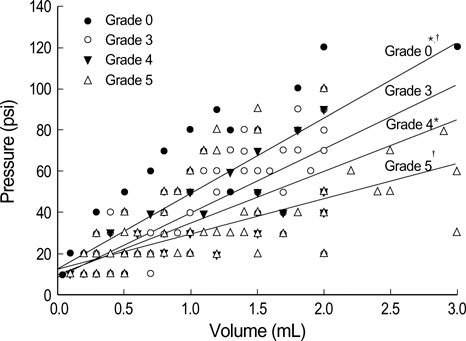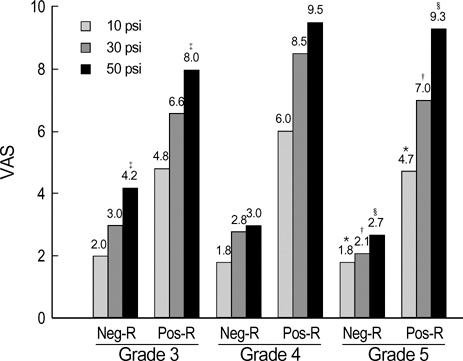J Korean Med Sci.
2006 Oct;21(5):911-916. 10.3346/jkms.2006.21.5.911.
Diagnostic Relevance of Pressure-Controlled Discography
- Affiliations
-
- 1Department of Neurosurgery, Presbyterian Medical Center, Jeonju, Korea. hyoungihl@hotmail.com
- KMID: 1781914
- DOI: http://doi.org/10.3346/jkms.2006.21.5.911
Abstract
- Discogenic pain is a leading cause of chronic low back pain. The authors investigated the efficacy of pressure-controlled discography to determine its role in clinical decision-making for the management of patients with discogenic pain. Pressure-controlled discography was performed in 21 patients (51 discs) with pain-provocation, followed by post-discography computerized tomography scans. Pain response was classified as positive response and negative response, and measured with visual analog scale scores. Discographic findings were graded by the modified Dallas discogram scale. Elastance, pain provocation on intradiscal pressure, pressure and volume of initial pain response, and pain response intensity were statistically analyzed. Elastance showed significant differences between Grade 0 and Grade 4 and 5. Decreased elastance with positive pain response group was a good indicator to imply that disc degeneration presumably is a pain generator. Results of pain response were well correlated with intradiscal pressure but not with the amount of injected volume. Among 31 discs of Grade 4 and 5, 74% showed negative pain response and 26% showed positive response. It was concluded that pressure-controlled discography was useful to diagnose discogenic pain and excellent guide in decision-making for spinal operations.
MeSH Terms
Figure
Cited by 2 articles
-
Causes and Diagnostic Strategies for Chronic Low Back Pain
Hyoung Ihl Kim, Dong-Gyu Shin
J Korean Med Assoc. 2007;50(6):482-493. doi: 10.5124/jkma.2007.50.6.482.Nonoperative interventions for spinal pain
Dong Ah Shin, Hyoung Ihl Kim
J Korean Med Assoc. 2014;57(4):308-317. doi: 10.5124/jkma.2014.57.4.308.
Reference
-
1. Mixter W, Barr J. Rupture of the intervertebral disc with involvement of the spinal canal. N Engl J Med. 1934. 211:210–215.
Article2. Deyo RA, Bigos SJ, Maravilla KR. Diagnostic imaging procedures for the lumbar spine. Ann Intern Med. 1989. 111:865–867.
Article3. Mink JH, Deutsch AL, Goldstein TB, Bray R, Pashman R, Armstrong II, Sinel M, Gart A. Spinal imaging and intervention: 1998. Phys Med Rehabil Clin N Am. 1998. 9:343–380.
Article4. Collins CD, Stack JP, O'Connell DJ, Walsh M, McManus FP, Redmond OM, Ennis JT. The role of discography in lumbar disc disease: a comparative study of magnetic resonance imaging and discography. Clin Radiol. 1990. 42:252–257.
Article5. Lurie JD, Birkmeyer NJ, Weinstein JN. Rates of advanced spinal imaging and spine surgery. Spine. 2003. 28:616–620.
Article6. Burton CV. Failed back surgery patients: the alarm bells are ringing. Surg Neurol. 2006. 65:5–6.
Article7. Ausman JI. I told you it was going to happen. Surg Neurol. 2004. 61:313–314.
Article8. Boos N, Rieder R, Schade V, Spratt KF, Semmer N, Aebi M. 1995 Volvo Award in clinical sciences. The diagnostic accuracy of magnetic resonance imaging, work perception, and psychosocial factors in identifying symptomatic disc herniations. Spine. 1995. 20:2613–2625.9. Osti OL, Fraser RD. MRI and discography of annular tears and intervertebral disc degeneration. A prospective clinical comparison. J Bone Joint Surg Br. 1992. 74:431–435.
Article10. Simmons JW, Emery SF, McMillin JN, Landa D, Kimmich SJ. Awake discography. A comparison study with magnetic resonance imaging. Spine. 1991. 16:S216–S221.11. Greenberg JO, Schnell RG. Magnetic resonance imaging of the lumbar spine in asymptomatic adults. Cooperative study--American Society of Neuroimaging. J Neuroimaging. 1991. 1:2–7.12. Spiliopoulou I, Korovessis P, Konstantinou D, Dimitracopoulos G. IgG and IgM concentration in the prolapsed human intervertebral disc and sciatica etiology. Spine. 1994. 19:1320–1323.
Article13. Roberts S, Eisenstein SM, Menage J, Evans EH, Ashton IK. Mechanoreceptors in intervertebral discs. Morphology, distribution, and neuropeptides. Spine. 1995. 20:2645–2651.14. Coppes MH, Marani E, Thomeer RT, Groen GJ. Innervation of "painful" lumbar discs. Spine. 1997. 22:2342–2349.
Article15. Saal JS, Franson RC, Dobrow R, Saal JA, White AH, Goldthwaite N. High levels of inflammatory phospholipase A2 activity in lumbar disc herniations. Spine. 1990. 15:674–678.
Article16. Braithwaite I, White J, Saifuddin A, Renton P, Taylor BA. Vertebral end-plate (Modic) changes on lumbar spine MRI: correlation with pain reproduction at lumbar discography. Eur Spine J. 1998. 7:363–368.
Article17. Brightbill TC, Pile N, Eichelberger RP, Whitman M Jr. Normal magnetic resonance imaging and abnormal discography in lumbar disc disruption. Spine. 1994. 19:1075–1077.
Article18. Buirski G, Silberstein M. The symptomatic lumbar disc in patients with low-back pain. Magnetic resonance imaging appearances in both a symptomatic and control population. Spine. 1993. 18:1808–1811.19. Carragee EJ, Chen Y, Tanner CM, Hayward C, Rossi M, Hagle C. Can discography cause long-term back symptoms in previously asymptomatic subjects? Spine. 2000. 25:1803–1808.
Article20. Sachs BL, Vanharanta H, Spivey MA, Guyer RD, Videman T, Rashbaum RF, Johnson RG, Hochschuler SH, Mooney V. Dallas discogram description. A new classification of CT/discography in low-back disorders. Spine. 1987. 12:287–294.
Article21. Derby R, Lee SH, Kim BJ, Chen Y, Aprill C, Bogduk N. Pressure-controlled lumbar discography in volunteers without low back symptoms. Pain Med. 2005. 6:213–221.
Article22. Derby R, Howard MW, Grant JM, Lettice JJ, Van Peteghem PK, Ryan DP. The ability of pressure-controlled discography to predict surgical and nonsurgical outcomes. Spine. 1999. 24:364–371.
Article23. Derby R, Kim BJ, Lee SH, Chen Y, Seo KS, Aprill C. Comparison of discographic findings in asymptomatic subject discs and the negative discs of chronic LBP patients: can discography distinguish asymptomatic discs among morphologically abnormal discs? Spine J. 2005. 5:389–394.
Article24. Olmarker K, Rydevik B, Nordborg C. Autologous nucleus pulposus induces neurophysiologic and histologic changes in porcine cauda equina nerve roots. Spine. 1993. 18:1425–1432.
Article25. Shin WR, Kim HI, Shin DG, Shin DA. Radiofrequency neurotomy of cervical medial branches for chronic cervicobrachialgia. J Korean Med Sci. 2006. 21:119–125.
Article26. Pfirrmann CW, Metzdorf A, Zanetti M, Hodler J, Boos N. Magnetic resonance classification of lumbar intervertebral disc degeneration. Spine. 2001. 26:1873–1878.
Article27. Tertti M, Paajanen H, Laato M, Aho H, Komu M, Kormano M. Disc degeneration in magnetic resonance imaging. A comparative biochemical, histologic, and radiologic study in cadaver spines. Spine. 1991. 16:629–634.28. Resnick DK, Choudhri TF, Dailey AT, Groff MW, Khoo L, Matz PG, Mummaneni P, Watters WC 3rd, Wang J, Walters BC, Hadley MN. Guidelines for the performance of fusion procedures for degenerative disease of the lumbar spine. Part 6: magnetic resonance imaging and discography for patient selection for lumbar fusion. J Neurosurg Spine. 2005. 2:662–669.
Article29. Resnick DK, Malone DG, Ryken TC. Guidelines for the use of discography for the diagnosis of painful degenerative lumbar disc disease. Neurosurg Focus. 2002. 13:E12.
Article30. Vanharanta H, Videman T, Sachs B, Spivey M. Computed tomography and discography in patients with spinal symptoms. Duodecim. 1988. 104:917–922.
- Full Text Links
- Actions
-
Cited
- CITED
-
- Close
- Share
- Similar articles
-
- Diagnostic Value of Image Findings of MRI and Discography for the Internal Disc Disruption
- Automated Pressure-Controlled Discography with Constant Injection Speed and Real-Time Pressure Measurement
- Significance of CT after discography
- Discograph - Plain and Axial
- Analysis of the Correlation Among Age, Disc Morphology, Positive Discography and Prognosis in Patients With Chronic Low Back Pain





